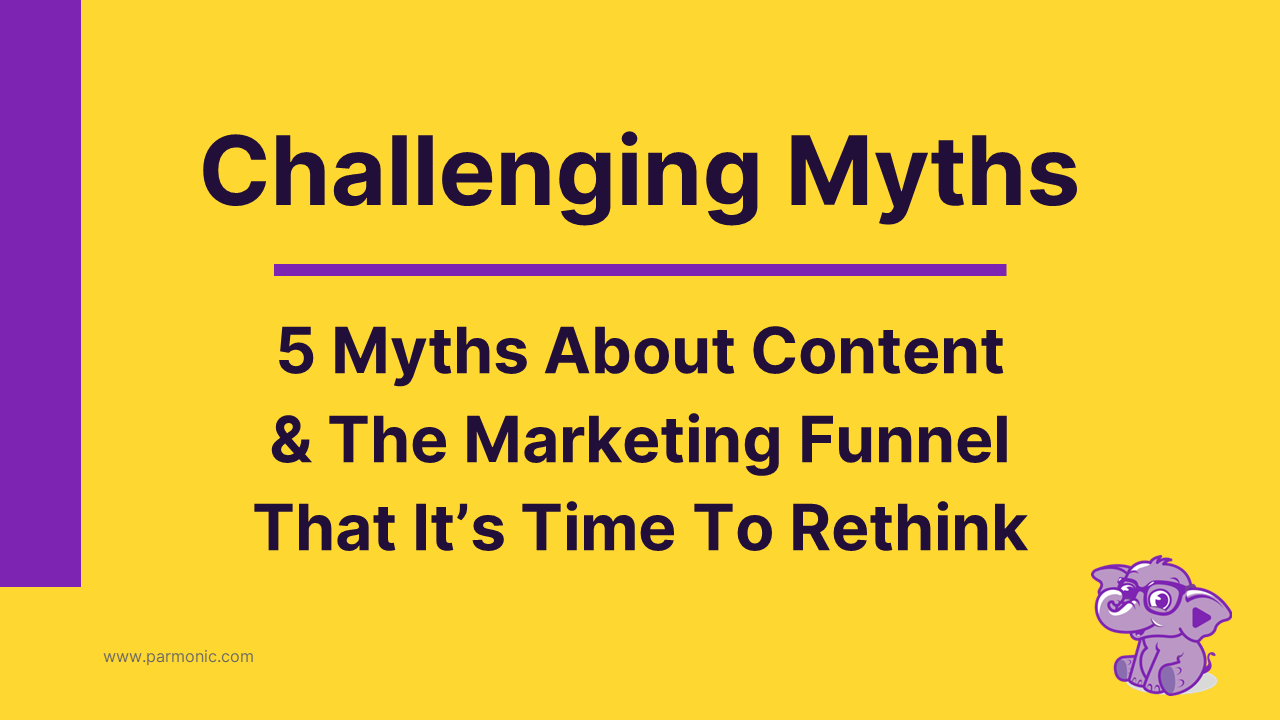Challenging Myths About Content and the Funnel
By Alisa Barber, Vice President of Marketing and Demand at Verint
and Daniel Brown, Vice President of Marketing Operations at Verint
As high-tech marketers we would love to always deliver exactly the right content at the right time for the right person via the right channel. However, it’s clear that achieving such perfection in every encounter is impossible.
This content dilemma certainly looms large for the funnel, as reaching a target persona to deliver ideal content for their stage in the funnel is incredibly challenging!
Unable to be as precise as we would like, we Marketers try to find balanced approaches that work for scenarios rather than individuals. Unfortunately, our efforts to find scalable ways to align content to the funnel have led to some myths. In this blog, we will identify some of these myths—and challenge conventional wisdom related to them.
Myth – Campaigns at the top of the funnel should focus on content for awareness.
This certainly sounds logical. People at the top of the funnel are often looking to get educated and discover what is possible. So, shouldn’t content help them learn and help them become aware of business problems in an industry and how companies solve them?
Of course, but the related myth is thinking that awareness is the only focus at the top of the funnel. The fact is that people coming into the top of the funnel could be anywhere in the buyer’s journey—awareness, interest, evaluation, or selection. Campaigns at the top of the funnel must provide simple avenues to a range of content, aligning to all the stages of the buyer’s journey.
Myth – Content must be ungated to avoid turning people away.
We know people conduct far more of their buying journey on their own, feeling empowered to gather intelligence to make decisions without Sales or Marketing help. To support modern buying behaviors, keeping content ungated is logical, but that would be a bad strategy when considering the funnel!
The best answer is a mix. Have plenty of open access content to support awareness and interest stages, but strategically gate content to ensure capturing leads for those entering evaluation and selection phases. Additionally, responders might not want to fill out a full 12-field form for an eBook, but they likely would for a full-length analyst research report. The level of effort a person should put in to acquire an asset should match the level of content included.
Myth – Campaigns and content should focus on high-ranking people that are likely decision makers.
Of course, you should do this, but not exclusively! The reality is that companies approach big purchases with committees, and often the most influential people in the buying process are day-to-day technical users—people that have the knowledge to assess a problem and evaluate potential solutions. Apparent decision makers are often simply acting on the recommendations of others in their organizations. Avoid the C-Suite trap—by gladly targeting a range of personas and working with all of them through the funnel.
Myth – “Prime” content must be saved for nurturing campaigns targeted at late funnel participants.
Prime content is precious, and by prime we mean content that would usually require a fee to access—such as a custom white paper written by an industry analyst. Reserving such content for nurturing is a big temptation, because we want to keep people moving through the funnel, we want our solutions to rank high as people evaluate, and of course we want selections to go in our favor. While prime content can help accelerate pipeline and influence final decisions, high-value content can also be important to getting people into the top of the funnel. Avoid another trap by strategically aligning prime content from the top to the bottom of the funnel.
Myth – Content should only be used once in a campaign.
While it is important to ensure campaigns have a variety of content that cover varying aspects of your product or organization, you do not need to limit content use! For example, a strong video asset might be great to use on a social post and a nurture email. Content can always be multipurpose, and people might interact with it differently depending on the channel they’re viewing it in. So don’t limit your content to one use in your campaign—instead think of the varying channels and ways an asset can help a contact along their buyer journey.
There is a common theme to these myths. The scenarios with each myth are valid, and there should be a content fulfillment plan for each one. HOWEVER, the overall content strategy can’t be that simple, that narrow and that focused! Sure, we need content for awareness. We want people to freely access content while they research. We do need to align content to high-ranking personas. And we need content for nurture campaigns. But avoid getting trapped by your content and limiting funnel potential by being too narrow in your approach!
Develop campaigns that focus on more than just awareness—running campaigns that seek leads from people entering evaluation and selection phases as well. Promoting your solutions with a multi-channel, integrated approach gives buyers the best option to see your valuable content no matter where they are in the buying cycle.
Have a gating strategy that identifies which types of content to gate, and which to leave open. Target high-ranking personas in campaigns, but make sure that lower-level personas are included as well, or run separate campaigns to make sure all relevant personas are reached. Do reserve some prime content for nurturing campaigns, but leave some for earlier funnel stages as well!
Simpler is often better…but not when it comes to content support of the funnel. Successfully leveraging content throughout the funnel requires a complex matrix of content—with a large number of relevant assets, spread across a wide range of content types, and designed for a wide spectrum of personas.


.jpg?width=800&height=800&name=Engaging%20Homo%20Distractus%20(1).jpg)
